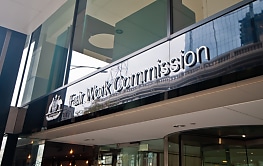
How space is used is a key consideration for employers as workers return to site following COVID-19 lockdowns. Now is a good time to consider the intersection between 'space' and psychology to get the most from on-site working.
HR Leader learned from Paul O’Halloran, partner at Colin Biggers & Paisley Lawyers and workplace relations accredited specialist, how physical workspaces can have an impact on a workforce’s psychology. Homing in on his experiences in the legal profession, Mr O’Halloran shared his thoughts on work environments — from Victorian-aged courts to modern open-plan offices.
Commenting on how working in closed-off and dark spaces can affect people, Mr O’Halloran stated “I think it’s probably not helpful for introverted people who just become more insular and inward focused, and I suspect it's not particularly great for the extroverts either who like to have people around them and not be in an office with no glass and an oak door closed."
“I think it reinforces a sense of hierarchy if you're in a very closed-off type of workplace that doesn't have a lot of transparency and has a lot of wood and a lot of closed doors", he added.
The reinforcement of hierarchy is an idea that Mr O’Halloran explored with HR Leader. “The Supreme Court of Victoria was probably one of the most interesting workplaces I've ever worked in, which was about 18 years ago. For those listeners that know, it's an old building on William Street in Melbourne built in the 1860s originally for about 10 judges. There's now well over 40 judges housed in that complex, not very comfortably. But it is designed in a very austere Victorian-era way.”
“When I worked there, I had an office, probably the best office I'll ever have, a heritage-listed office across the hallway from the chief justice's chambers. There are lamps on the walls. There are stone floors. There are large oak doors. There's not a lot of glass in there. There are portraits of long dead judges that line the walls, not much sunlight. I think that contributed, in my view, to the psychology of those people that worked in that building.
“Now, I think because it was a Victorian-era building, it was built in a way to instil obedience in the court users that went there and the justice that was administered in that building. But, also as a young law student studying law and working in the chief justice's chambers at the time, I felt there was a real hierarchy in the building. The judges would walk around with their wigs and robes on even behind the scenes. I think that really instilled a sense of obedience and deference. The judges seemed quite unapproachable to me.”
Mr O’Halloran went on to note “That's one extreme, but I think the other extreme is the very open-plan type office environment that we see today.”
Open plan offices aren’t for everyone, Mr O’Halloran says. “What I see at the other end of the spectrum with workplaces that are very open-plan, perhaps the bank call centre type scenario that people think about, is that it's so confronting to many people and detracts from the collaborative environment that it intends to facilitate. Research that I've seen shows that in some of those very open-plan type environments, there's actually a 70% decrease in collaboration because what it tends to do is trigger people's natural response to withdraw socially and avoid their officemates.
“I think it's probably not unusual to look around most contemporary office spaces these days and see, particularly younger people, with their iPods in listening to music, trying not to be in the space that they're in. Sometimes it's for concentration. But I think there's got to be a happy medium between those two things: instilling fear and not wanting to approach anybody in the really austere environments, and people wanting to withdraw from others in the very open-plan environments,” he added.
“I'm not a behavioural scientist. I am a lawyer, but I'm a workplace relations lawyer. I guess in that context, you see workplace psychology from a particular angle play out", Mr O’Halloran explained at the start of the conversation.
He continued “I think the link between architecture and psychology is not a new thing. If we think about courtrooms, for example, they're designed in a particular way to probably instil fear into defendants or prisoners, particularly those built at the turn of the century. Prisons, I think, have a certain design element to them, obviously, to instil obedience. So, I find that really interesting just from a workplace perspective and working in a law firm how that plays out in that context as well."
The transcript of this podcast episode when quoted above was slightly edited for publishing purposes. To listen to the full conversation with Paul O'Halloran, click below:
Shandel McAuliffe
Shandel has recently returned to Australia after working in the UK for eight years. Shandel's experience in the UK included over three years at the CIPD in their marketing, marcomms and events teams, followed by two plus years with The Adecco Group UK&I in marketing, PR, internal comms and project management. Cementing Shandel's experience in the HR industry, she was the head of content for Cezanne HR, a full-lifecycle HR software solution, for the two years prior to her return to Australia.
Shandel has previous experience as a copy writer, proofreader and copy editor, and a keen interest in HR, leadership and psychology. She's excited to be at the helm of HR Leader as its editor, bringing new and innovative ideas to the publication's audience, drawing on her time overseas and learning from experts closer to home in Australia.










